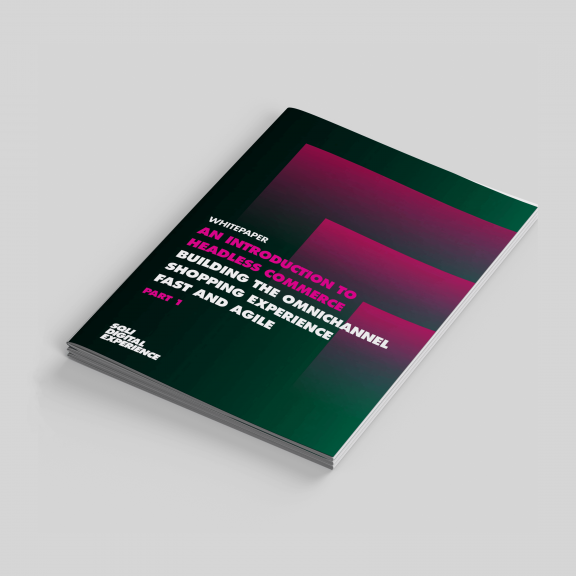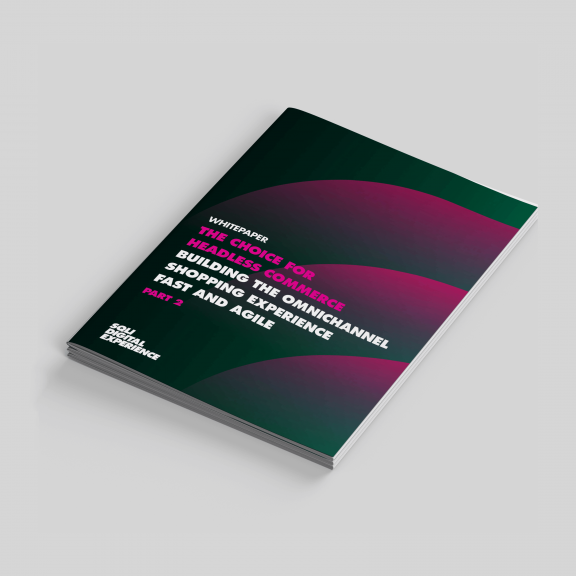
The Choice for Headless Commerce
Discover what is Headless Commerce - the e-commerce approach that decouples the front-end and back-end, enabling more flexibility and personalization in user experience - and what are the business benefits.
What is Headless Commerce?
As a technology approach, headless commerce keeps change and evolution foremost in mind. Essential to headless commerce is the decoupling of the customer-facing front end from the back-end layer. Headless means it runs without a graphical user interface (GUI). All applications and hardware can be headless, but typically you’ll see headless computers (most often servers) and headless websites. Without the GUI, inputs and outputs go via interfaces like network, serial port or command lines. The focus lies on efficiency and not on user-friendliness. Instead of developing a complex GUI that requires a graphics card or an interface like the mouse or keyboard, you can more easily monitor, maintain and automate the process. That’s where headless gets interesting.
Making the website headless
The internet started with static HTML offered by the website which was interpreted by the user’s browser. With the rise of CMS came an extra layer of abstraction. The website owner puts his content in the database, usually PHP, which gets rendered into HTML. That’s where most websites are now: software installed on the server that holds all the functionality to maintain the website and present its contents to visitors. The CMS provides a WYSIWYG experience: what you see is what you get. You can immediately see how your changes impact the presentation.
Headless Commerce explained
The headless website adds another layer between the website editor and the end user. The front end where the website is presented, is decoupled from the back end where the website editor works on the content. In a headless website, the front end and back end operate separately from each other. The biggest advantages of going headless are performance and flexibility, because it allows you to optimize the front end and the back end independently.
The Head: the front-end
The head is the presentation layer of an application. For a website, it is the user interface (UI) visitors interact with by clicking their mouse or tapping buttons. The UI reacts to their input, by showing new information or performing tasks such as adding products to a digital shopping basket. Although the term front end implies a graphical user interface (GUI) displayed on some kind of screen, the front end can also be voice, chatbots, social platforms, IoT or even augmented and virtual reality.
The Body: the back-end
The back-end is where it all happens inside your organization. It’s the operational layer that contains all the business logic and that’s responsible for the data crunching and heavy lifting. Invisible in the background, the back end enables key functions like infrastructure, inventory and warehouse management, customer information, order and return process.
These business functions are enabled by solutions like ERP, CRM, PLM, MDM and PIM, all of which are part of the back end. Basically, the back end consists of any application you might have running on your servers or in the cloud. By going headless, these functions can run entirely separately from the front-end interaction. Whether an order is placed through a mobile app or put in the system by an inside sales agent, the back end stores and processes it blindly.
API for bridging the front end and back end
API is the layer that works as a glue between the front end and back end. Through API, all the information travels back-and-forth from the business processes to the presentation. That makes it possible to quickly connect a new application, turning every application into a service and making your infrastructure highly flexible. APIs are like user-interfaces but for other software. This allows you to decouple the functionality and data from the presentation in a headless approach. Especially for commerce API brings key benefits.
Business benefits of Headless Commerce
Being able to deliver omnichannel shopping experiences is what keeps your business running. The ability to quickly respond and anticipate to change, is what will ensure your position for the long run. Headless commerce gives you the freedom to create personalized and connected digital experiences across all channels. As an architecture, it allows you to experiment, quickly add new channels, increase your business agility and scale efficiently.
Headless commerce comes with the following six business benefits:
1. Create omnichannel shopping experiences
Headless commerce allows your products, videos, blogs and rich content to be presented and shared on any channel. Your content can be delivered anywhere and everywhere, blended with commerce. With all your back-end systems integrated with your front ends, data flows freely in both directions. That enables data integrity and a 360-degree customer view, through which you can make product recommendations, advertise using retargeting and execute personalized marketing campaigns that stretch over different touchpoints. Whichever channel your customer uses, you can present a seamless and personalized experience that leads to increased customer satisfaction and revenue.
2. Build and customize your architecture
Do you want to use a particular application or unlock a new channel? Using a headless architecture, you decide how a front end is structured. You do not have to stick to a specific templating system or train your employees to follow the exact rules the software vendor laid out. Instead, you can build exactly the user interface your particular customers want and choose the application that suits best. From the inspiration and product pages to the checkout process and fulfilment, each step can be optimized separately. You have full control of what happens in the front end, and you can follow your UX design principles and shape your brand’s identity. This strengthens your brand recognition and results in higher customer conversions and increased lifetime value.
3. Freedom to experiment
Anticipating customer needs requires continuous experimentation. Without the risk of jeopardizing the whole ecosystem, you can experiment and try out things in a headless architecture. For example, if you would like to A/B test specific parts of your commerce websites, build an Alexa skill or a fast and shiny Progressive Web App (PWA), there is room for error in the process without affecting the back-end operations. In contrast, with traditional commerce solutions, you often have to modify front end and back-end code simultaneously, sometimes needing to shut down the entire application for maintenance. With headless commerce, you’ll be able to learn faster and save on development costs.
4. Speed and agility
With the freedom to experiment, you can implement new user interfaces more quickly instead of installing and then maintaining a full-stack software. Development becomes much more efficient because teams can now work in parallel. Due to its decoupled nature, changes can be made to the UI without having to test all the core logic in the back end. Changes can be made on the fly to keep up with the speed of consumer technology. This will give you reduced time-to-market and development efficiency.
5. Scaling with ease
In a traditional monolith software solution scaling typically goes horizontal. But when your architecture is headless, front end and back end can be individually scaled vertically. You only scale what you need. Even if the front end receives a lot of traffic, the back end stays unaffected since they are only loosely coupled. This way, operational costs are reduced and availability is stabilized.
6. Quick deployment in new channels and markets
In a headless scenario, multiple front ends connect to one API and one underlying system. This makes adding new touchpoints easy, as you do not have to worry about maintaining a software “mish-mash.” And if you’re looking to set up a new international website, you can do that in a matter of weeks instead of months due to custom coding. This allows your business to quickly establish presence in new channels and markets and quickly respond to changing customer needs.
Should you go Headless?
Just like every other architecture, there are also downsides next to the business benefits. While these can be tackled by most organizations, it makes the headless commerce approach not suitable for everybody. In our white paper we explain the disadvantages and how to approach these, explore the impact on your organization and give you the facts to build a solid foundation for the choice for headless commerce.
This is the fifth article in our article series on evolutionary architecture. You can learn about the underlying principles such as microservices, API, cloud commerce, headless commerce and event-driven architecture on this page in depth.
About SQLI
Established in the 90's, SQLI is one of the largest European services groups dedicated to the digital business; we are specialised in the design, implementation, global deployment and operation of omnichannel commerce solutions. Many of our clients are market leaders. Our goal is to help them evolve their business model so they can excel in every market or channel. SQLI helps businesses reach B2B and B2C clients with a seamless experience in every channel they're active. Using our expertise in Evolutionary Architecture & Microservices, we can create the right fundamentals for an Omnichannel presence. This results in an e-commerce solution that enables a complete brand experience and drives sales.
Did we pique your interest?
Get in touch to discuss how we can drive your digital success.
CONTACT US




